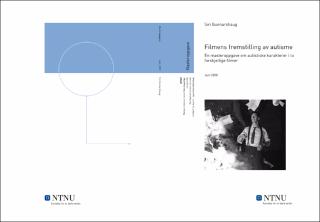| dc.contributor.advisor | Bakøy, Eva | |
| dc.contributor.author | Gunnarshaug, Siri | |
| dc.date.accessioned | 2021-09-14T16:06:04Z | |
| dc.date.available | 2021-09-14T16:06:04Z | |
| dc.date.issued | 2020 | |
| dc.identifier | no.ntnu:inspera:53759382:36542886 | |
| dc.identifier.uri | https://hdl.handle.net/11250/2776591 | |
| dc.description.abstract | Denne masteroppgaven undersøker hvordan autismediagnosen blir konstruert og fortalt i en begrenset tidsramme igjennom samtidstekster. De valgte tekstene for analysene er spillefilmene The Imitation Game (Tyldum, 2014) og Rain Man (Levinson, 1988), som begge tilsynelatende omhandler karakterer på det autistiske spekteret. Ved å anvende disse tekstene, er målet med oppgaven å se hvordan tekstene inviterer tilskueren til å forstå diagnosen, og hvordan tekstene konstruerer karakterenes atferd med stereotypiske karakteristikker fra diagnosen.
For å gjøre dette, er analysen hovedsakelig basert på autismespekteret og dets forskjellige trekk av forfatterne Øzerk & Øzerk og Nils Kaland. Jeg vil også anvende den sentrale sympatistrukturen presentert av Murray Smith fra feltet kognitiv filmteori, dette inkluderer å se på hvordan tekstene plasserer og konstruerer en troskap til karakteren. Jeg vil også ta med sjangerteori for å undersøke hvilke fortellertrekk som blir brukt i forestillingen om de autistiske karakterene. Etter hvert, kommer det frem i oppgaven hvordan tekstene følger den typiske Hollywood strukturen og et likt handlingsmønster via Anthony Bakers autistiske formel. | |
| dc.description.abstract | This thesis sets to investigate how the autism diagnosis is constructed and told in a limited timeframe through contemporary texts. The chosen texts for the analysis are the feature films The Imitation Game and Rain Man, which both seemingly deals with characters on the autistic spectrum. Using these texts, the aim for this analysis is to see how they invite the audience to understand the diagnosis and look at how they construct the characters’ behavior with stereotypical key traits from the diagnosis.
To do so, the analysis is mainly grounded on the autism spectrum and its different traits by the authors Øzerk & Øzerk and Nils Kaland. I will also apply the central sympathy structure presented by Murray Smith, from the field of cognitive film theory, which includes looking at how the texts places and construct an allegiance to the character. I will also include genre theory in order to examine which storytelling traits that is being used in the notion of the autistic characters. Gradually, the thesis reveals that the texts follow a typical Hollywood structure and a similar pattern of action via Anthony Baker's autistic formula. | |
| dc.language | | |
| dc.publisher | NTNU | |
| dc.title | Filmens fremstilling av autisme | |
| dc.type | Master thesis | |
